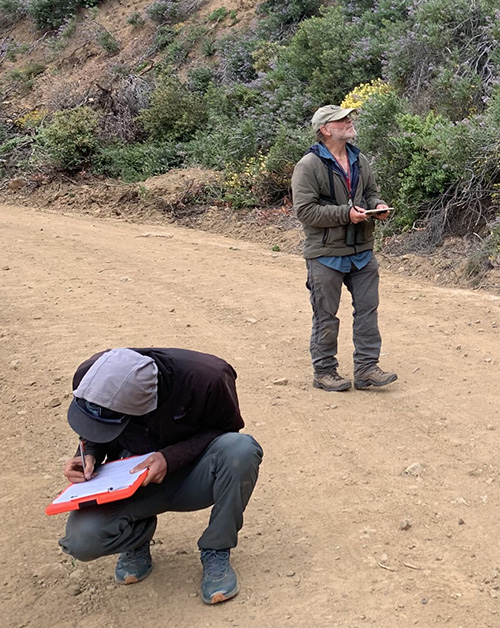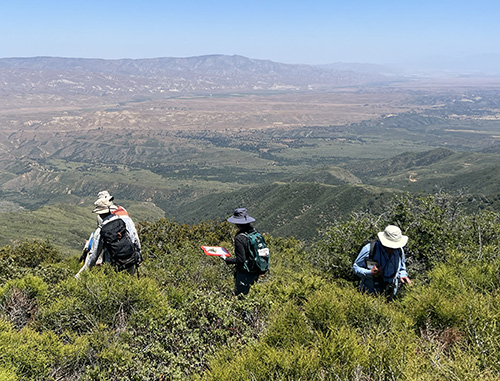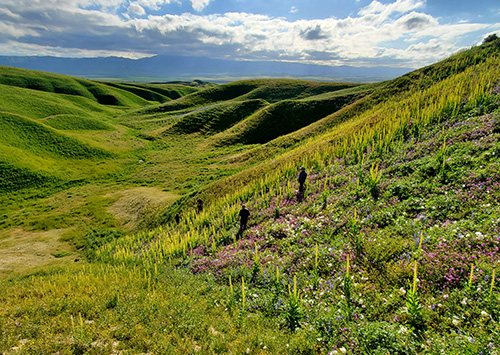The California Department of Fish and Wildlife (CDFW) has awarded a $2.6 million contract to the UC Santa Cruz Arboretum & Botanic Garden to conduct vegetation surveys in support of the statewide Vegetation Classification and Mapping Program (VegCAMP).
A team of botanists led by Brett Hall, director of the Arboretum’s California Native Plant Program, will carry out the surveys, focusing primarily on three main geographic areas: the Northern Sierra Nevada, Central California Interior Coast Ranges, and Northern California Interior Coast Ranges.
“This is important conservation work for the state,” Hall said. “Many vegetation types are becoming rare or face threats from fragmentation and invasive weeds, and this project will allow us to see what we have in California on a fine scale and make that information available to support conservation and management decisions.”
The VegCAMP program aims to survey the entire state according to new protocols developed by CDFW and the California Native Plant Society for sampling and classifying vegetation types. These protocols comply with state and federal standards and will provide a more consistent and accurate representation of vegetation types throughout the state.
The Arboretum team will be focusing on areas of the state that have not previously been surveyed using these protocols. Other groups are also involved in the VegCAMP effort, which has received $20 million in funding from the state.
Lucy Ferneyhough, project manager for the Arboretum’s Native Plant Program, said all the data they collect will be publicly available. “Vegetation maps have been completed for a few areas and are available for land managers,” she said. “These maps can help with fire planning and vegetation management and can help land trusts determine where to acquire land to create effective habitat corridors.”
Arboretum botanist Alex Hubner emphasized the importance of having good baseline data on California’s vegetation types. “We don’t necessarily know what’s out there, and we need to get a snapshot of what we have now so we can observe how it changes and identify areas that are at risk and in need of management,” he said.
Hubner explained that when the team heads out to a site, they start with a general idea of what might be there, but what they find in the field directs the survey process. “We’re trying to find plant community types that are recurring and predictable across the landscape,” he said. “There might be a stand of chamise, and then another area with chamise and bigberry manzanita, and those are two distinct vegetation types, so we’ll do a survey within each type to represent those plant communities.”
The mapping side of the program relies on aerial imagery of the landscape. By looking at the data collected in the field and correlating it with the overhead images, mappers can predict the locations and extent of each vegetation type.
According to Ferneyhough, conservation efforts have often tended to focus on individual species rather than communities and ecosystems. “Vegetation mapping can direct more attention to rare communities and habitats, so we can prioritize the protection of entire habitats,” she said.
Hall, Ferneyhough, and Hubner have been involved in several earlier surveys using the VegCAMP protocols, giving them the expertise CDFW sought for the new contract. They are hiring a team of experienced botanists to join them in this project, including two recent graduates of UCSC who worked at the Arboretum as student interns.
“The Native Plant Program at the Arboretum is a far-reaching effort to collect good plant materials for education, research, and conservation purposes,” Hall said. “We are learning a great deal about the state’s vegetation through this new project, and the knowledge and skills we gain will help us teach students how to look at vegetation and understand the new classifications.”






